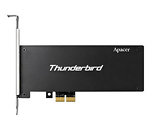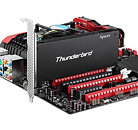Friday, October 3rd 2014

Apacer Announces the PT910 PCI-Express SSD
For professional gamers to win fierce fights easily, Apacer, the pioneer in digital storage, launches the latest SSD - Apacer PT910 SSD. It adopts the ultra-high-speed interfaces PCI-E 2.0 x 2, reaching amazing sequential read/write speeds of 830/790 MB/s and 4K random read/write speeds up to 100,000 IOPS.
With the dual controller from the top brand SandForce and the chips from the tech giant Intel, the product is available in 256 GB and 512 GB, of which the real capacities are 7% larger than other same-level products.PT910's multiple advantages of high efficiency, high reliability and high cost-performance ratio allow computer game experts, musicians and audio/video workers to enjoy a more pleasant and smooth digital experiences.Breaking the interface limitations, reaching a read/write speed of 830/790 MB/s
Speed is an eternal pursuit for professional gamers. The Apacer PT910 PCI-E SSD, with PCI-E 2.0 x 2 high-speed interfaces, is compatible with the PCI-E x4/x8/x16 slot. It breaks the transmission limitations and reaches a sequential read/write speed of 830/790 MB/s and a 4K random read/write speed of up to 100,000 IOPS (Input/Output Per Second). Game downloading and execution can be completed in the blink of an eye. With its superior speed experience and excellent cost-performance, it will surely become the best choice for game players!
Capacity increasing by 7% than the same-level products, providing a high-speed experience and cost-efficiency
The PT910 PCI-E SSD is available in two capacities: 256 GB and 512 GB, which offer superior cost-performance surpassing products of the same type and level (240 GB, 480 GB) by nearly 7%. It provides a high-speed and smooth read/write experience for system work or start-up disk, playing computer games, or editing video and audio files. As a PT910 professional gamers, you are able to take a head start in the virtual world, while other gamers are still "loading" and "starting up".
The PT910 PCI-E SSD adopts a low profile design. Its flexibly applies to computer cases of different sizes and facilitates route setting and heat dissipation inside the cases. Moreover, the PT910 PCI-E SSD does not require any drivers installed before use. Its easy operations of installation and upgrading greatly satisfy professional gamers and DIY experts.
Stable and durable SSD with multiple security schemes
Reliability-wise, PT910 PCI-E SSD is built in with disk sector management, power disruption management and error-correcting mechanisms. The PCI-E interfaced solid state drive also supports Windows TRIM command to provide professional gamers a worry-free platform.
With the dual controller from the top brand SandForce and the chips from the tech giant Intel, the product is available in 256 GB and 512 GB, of which the real capacities are 7% larger than other same-level products.PT910's multiple advantages of high efficiency, high reliability and high cost-performance ratio allow computer game experts, musicians and audio/video workers to enjoy a more pleasant and smooth digital experiences.Breaking the interface limitations, reaching a read/write speed of 830/790 MB/s
Speed is an eternal pursuit for professional gamers. The Apacer PT910 PCI-E SSD, with PCI-E 2.0 x 2 high-speed interfaces, is compatible with the PCI-E x4/x8/x16 slot. It breaks the transmission limitations and reaches a sequential read/write speed of 830/790 MB/s and a 4K random read/write speed of up to 100,000 IOPS (Input/Output Per Second). Game downloading and execution can be completed in the blink of an eye. With its superior speed experience and excellent cost-performance, it will surely become the best choice for game players!
Capacity increasing by 7% than the same-level products, providing a high-speed experience and cost-efficiency
The PT910 PCI-E SSD is available in two capacities: 256 GB and 512 GB, which offer superior cost-performance surpassing products of the same type and level (240 GB, 480 GB) by nearly 7%. It provides a high-speed and smooth read/write experience for system work or start-up disk, playing computer games, or editing video and audio files. As a PT910 professional gamers, you are able to take a head start in the virtual world, while other gamers are still "loading" and "starting up".
The PT910 PCI-E SSD adopts a low profile design. Its flexibly applies to computer cases of different sizes and facilitates route setting and heat dissipation inside the cases. Moreover, the PT910 PCI-E SSD does not require any drivers installed before use. Its easy operations of installation and upgrading greatly satisfy professional gamers and DIY experts.
Stable and durable SSD with multiple security schemes
Reliability-wise, PT910 PCI-E SSD is built in with disk sector management, power disruption management and error-correcting mechanisms. The PCI-E interfaced solid state drive also supports Windows TRIM command to provide professional gamers a worry-free platform.


16 Comments on Apacer Announces the PT910 PCI-Express SSD
I raided my GT's up and they are hitting 950MBs and tell you the truth it's not worth doing.
What I'd rather see is an M.2 adapter - three four lane M.2 ports that accept the 110mm sticks. I've drawn up this complete accurate schematic to save an engineer some time ;)
On a side note, what stripe size do you have on your GT RAID? I've played around with 128k and 4k and each have their benefits and down sides. I'm thinking of formatting soon and giving 16k or 32k a try instead to see how a middle ground fairs, because I get capped at about 850MB/s with 4k blocks but 128k will give me 1GB/s but is more harmful to random reads and writes.
Also in all seriousness, I don't feel a difference in responsiveness going from one to two in RAID-0. The only time I notice it is if I'm copying something huge, like a VM image.Even IOPS eventually has diminishing returns because disk I/O is hardly the majority of what games are doing. It's just another way of making sure you make the disk less of a bottleneck than it already isn't. The bottom line is that all it might get you is a couple seconds off your load time, that's it.
Also, I was not sure that it would operate in that fashion. I know network switches do (ex: 1Gb with 10Gb uplink) but does PCIe design allow a PEX switch do the same? Nice if it did, especially for a card with more ports but I'd be happy with my adapter. Start with a single 512GB/1TB stick, then add 2TB (or greater) sticks when they're available. Performance is more than adequate for me (and most of the people in this thread, going by their comments).
Classic PCI-Ex SSD at this moment in time are total waste of time. What Jizzler suggested is much more interesting and I've seen some stuff similar to that, although only for one M.2 not 3-4. I would buy such card immediately. Much more logical than cramming M.2 SSD on the motherboard itself, below all expansion cards where airflow is non-existent.
Maybe it would have been a good idea if they where selling that PCIe adapter alone for $30 for example, so that anyone with two identical SSDs build his own PCIe boot drive.
These things should be around the same prices as standard SSD's the express interface is only a handful of dollars seen plenty of Xpress x 4 devices under $100.
It's even easier to get the same speeds using MX100's in raid you can get a TB raid drive with the same speeds as express drives for under $500.